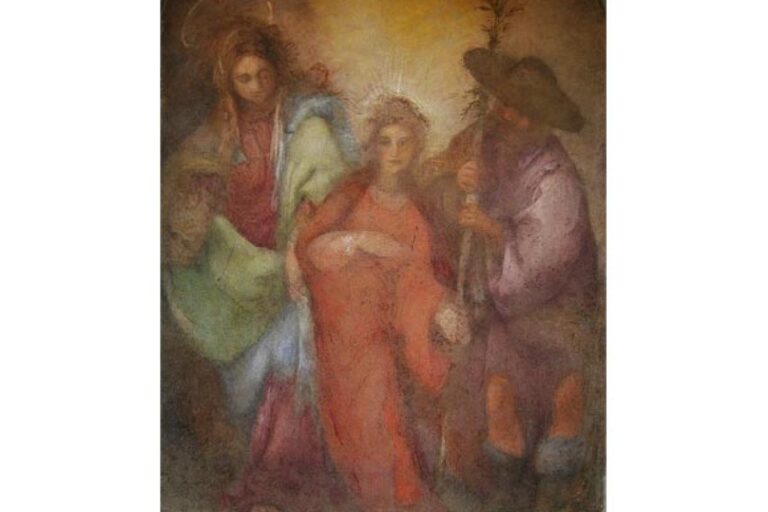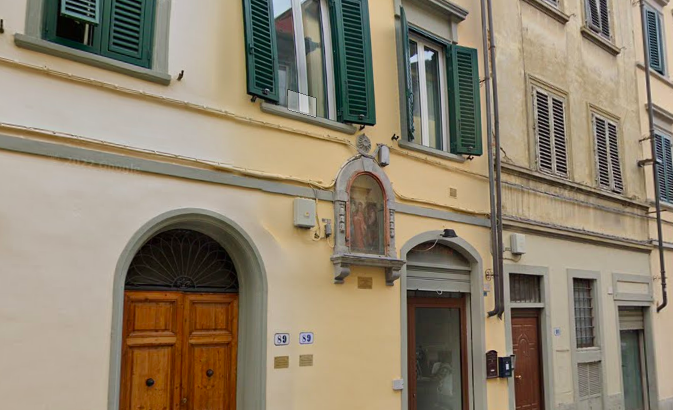Tabernacles of Florence
Via Palazzuolo n.89
THE TABERNACLE
Sacra Famiglia
The "Sacra Famiglia" (Holy Family) is depicted during the return to Galilea after the flight from Egypt. Giuseppe (Joseph) and Maria (Mary) walk alongside a boy Jesus, who wears a red tunic, a probable allusion to the blood shed in martyrdom and thus an anticipation of Jesus' mission. We find several innovations on the theological level due to the influence of the counter-reformation. First, Jesus is depicted as a child rather than an infant, thus more aware of his mission. In addition, there is a call to an austere simplicity of life that is captured in the intimate and collected atmosphere of the scene, in the familiar ways in which the parents huddle around their son and together follow his path. Finally, San Giuseppe (St. Joseph) was no longer depicted as an elderly, white-bearded parent, but as a young father.
Tabernacle
The tabernacle is in pietra serena, surmounted by the symbol of San Bernardino and supported by pilasters with decorative plant pendant motifs. Inside the niche there is a fresco, attributed at first to Giovanni da San Giovanni but later recognized as the work of Cecco Bravo, depicting the Holy Family.
THE STREET
VIA PALAZZUOLO
According to tradition it was the "Palagetto dei Sovajoli," already in existence at the end of the 14th century, that gave a name to Via Palazzuolo, in the people of Santa Lucia d'Ognissanti. The street, in the first section outside the Porta a San Paolo (located in the area of today's Piazza Ottaviani), took the usual village name given to extra moenia streets and was named after San Paolo.
AUTHOR
Cecco Bravo
(Florence, November 15, 1601 - Innsbruck, December 1661) Francesco Montelatici, known as Cecco Bravo, was a well-known painter in the Florentine artistic milieu. He served an apprenticeship under Giovanni Bilivert, court painter to grand duke Cosimo II de' Medici. It was a richly stimulating context, where Cecco had the opportunity to compare himself with many foreign artists.
The artist
(Florence, November 15, 1601 - Innsbruck, December 1661) Although undocumented, his collaboration with Matteo Rosselli was instead decisive; during these years he obtained a number of prestigious pictorial commissions from the ducal family and could moreover offer Montelatici the opportunity to try his hand at fresco technique. On June 1, 1660, he moved to Innsbruck to the court of archduke Ferdinando Carlo d’Austria (Ferdinand Charles of Austria) and Anna de' Medici, Counts of Tyrol, driven perhaps by a growing sense of estrangement from the Florentine artistic milieu, where trends increasingly distant from his anti-academic spirit were now emerging.
Curiosity
The choice of the subject depicted is not accidental: it was in fact in this period, following the Council of Trent, that the subject of the Holy Family, proposed as an exemplary model of Christian life, was first introduced in tabernacle paintings.
OTHER INFORMATION
Info
AMICI DEI MUSEI FIORENTINI ODV - COMITATO PER IL DECORO E IL RESTAURO DEI TABERNACOLI - File by Chiara Sestini and Doretta Ermini - Restorer: Daniela Murphy Corella - Work direction: Dr. Anna Bisceglia - Funders: SACI Studio Art Centers International, Florence, Participants in the 2010 Mario Borino Trophy, Committee of residents and artisans of Via Palazzuolo (2010)
PICTURES

Fresco's detail: Maria
Via Palazzuolo 89

Fresco
Via Palazzuolo 89

Streetview
Via Palazzuolo 89
